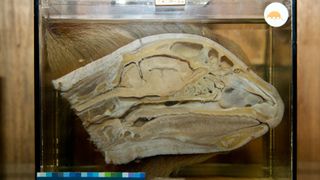
(Image credit: Jennifer Santolla via Alamy Stock Photo)
If terms like “bird brain” and “harebrained” are any indication, animal brains present fascinating and diverse examples of one of the most complex organs known to science. Animal brains differ not only in overall size but also in their size relative to the animal’s body mass.
At 18 pounds (8 kilograms), on average, the sperm whale (Physeter macrocephalus) has the largest brain, but has an overall body mass of 45 tons (40 metric tons), giving it a brain-to-body-mass ratio of 1:5,100. But which animal has the biggest brain relative to its body size?
A 2009 study in the journal Brain, Behavior and Evolution (opens in new tab) found that an especially tiny genus of ant has the largest brain for its body size. Brachymyrmex has an average body mass of up to 0.049 milligrams and an average brain mass of 0.006 milligram. That means its brain is roughly 12% of its body mass, giving it a brain-to-body-mass ratio of about 1:8.
Related: Why do our brains have folds?
Why do animals evolve larger brains?
In absolute terms, animals’ brain size tends to increase with the size of the animal. Bigger brains are typically related to three factors: “maternal investment, complexity of behavior and the sheer size of the body,” said Sophie Scott, a professor of cognitive neuroscience at University College London.
“Having a bigger body means needing to control that more,” Scott told Live Science. “Apex predators tend to be big. And because of a need for more complex behavior, like being able to outwit your prey, they benefit from having a bigger brain.”
But, brain size isn’t a perfect predictor of animal intelligence. The brain of an African elephant (Loxodonta africana) weighs 10 pounds (4.6 kg), on average, according to a 2014 study in the journal Frontiers in Neuroanatomy (opens in new tab), three times larger than the human brain. Their large brain size is due in part to their massive cerebellum, used to coordinate the muscle activity in their trunk and ears, according to Scott.

Just as absolute brain size isn’t a good predictor of animal intelligence, comparing brain-to-body mass ratios can also be a red herring. Humans and rodents have a roughly similar brain-to-body mass ratio (1:40), according to a 2009 study in the journal Frontiers in Human Neuroscience (opens in new tab). However, the same study argues that if a rat were human-size, it wouldn’t be as intelligent because it has a smaller cerebral cortex (the outermost area of the brain, which is associated with the most complex mental functions) and fewer neurons there than humans do.
“If you look at the brain of a rabbit, a cat and a small monkey, they’re not that different in size, but their behavior is going to be very different because of the nature of the brain cells,” Scott said. “By the time you get to the monkey, you’re seeing a primate brain, with proportionally larger frontal lobe areas and more curiosity-driven behavior.”
Scott explained that evolutionary adaptations change the brain’s structure to increase the size of certain areas and favor certain neural connections. In humans, the size of our cerebral cortex and the density of cortical neurons (the number of neurons present there) explain our intelligence more than the size of our brains relative to our bodies. Compared with other animals “we have quite a small body for the size of our brains,” Scott said.
When comparing brains of different species, it’s important to consider brain architecture as well as brain size. Because brain-to-body-mass ratio does not take into account the evolutionary development of the cerebral cortex and the density of neural connections found there, scientists look to encephalization quotient (EQ) as a more accurate measure of animal intelligence. The encephalization quotient is the relative brain size observed in a particular species, compared with the expected brain size of other species of a similar body size. One key factor in EQ is the relative size of the cortex compared with the rest of the brain. Comparing animals based on their EQ provides a more accurate view of their intelligence than brain-to-body-mass-ratio, according to the Encyclopedia of Behavioral Neuroscience (opens in new tab), though not as accurate as measuring the absolute size and interaction of individual brain regions.
Related: Are cats or dogs smarter?
Then, there’s a concept known as Haller’s rule: The bigger the animal is, the smaller the brain-to-body ratio will be. “Because brain size scales relative to body size, the smallest animals have relatively the largest brains,” Wulfila Gronenberg, a professor of neurobiology at the University of Arizona, told Live Science.
For example, ants have relatively small brains compared with other hymenoptera, a class that includes bees, wasps, hornets and sawflies. “We think this is because … ant workers don’t fly,” Gronenberg said. Flying requires a lot of visual processing, so many flying insects typically have large eyes, thus leading to larger optical lobes. “In some insects, like a dragonfly, visual processing is more than half of their entire brain,” Gronenberg said.
Originally published on Live Science.

Martin McGuigan is an Irish writer based in Norwich, England. His work has appeared in The Mays XIX, Cabinet of the Heed and SHE magazine. His writing explores the bizarre questions of everyday life, the mysteries of human psychology, and environmental issues. He studied English literature at the University of Cambridge and creative writing at the University of East Anglia.
Note: This article have been indexed to our site. We do not claim legitimacy, ownership or copyright of any of the content above. To see the article at original source Click Here












